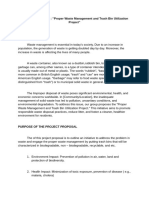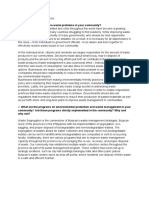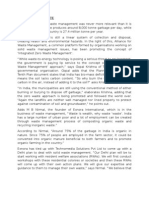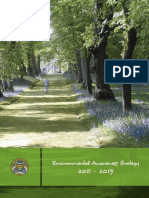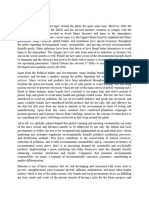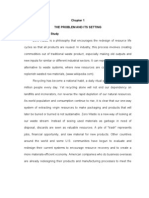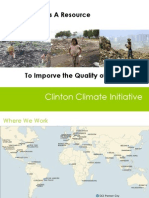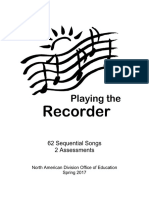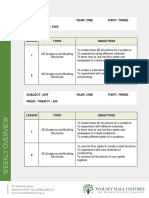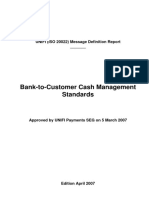Minutes of CGI Informal Waste Management Thinking Group, 2010
Minutes of CGI Informal Waste Management Thinking Group, 2010
Uploaded by
virtuallyunboundCopyright:
Available Formats
Minutes of CGI Informal Waste Management Thinking Group, 2010
Minutes of CGI Informal Waste Management Thinking Group, 2010
Uploaded by
virtuallyunboundCopyright
Available Formats
Share this document
Did you find this document useful?
Is this content inappropriate?
Copyright:
Available Formats
Minutes of CGI Informal Waste Management Thinking Group, 2010
Minutes of CGI Informal Waste Management Thinking Group, 2010
Uploaded by
virtuallyunboundCopyright:
Available Formats
CGI Informal Waste Management Thinking Group
Meeting Septe mber 20, 2010 Meeting Summary
ATTENDEES Penny Abeywardena, Clinton Global Initiative Kelly Anchrum, Procter & Gamble (by phone) Roxanne Cason, Cason Family Foundation Ann Marie Cofield, Cason Family Foundation Peter Cohen, Ph.D., World Bank (by phone) Bill Davis, Ze-gen, Inc. Mark Dawes, Dawes Direct, LLC; Procter & Gamble Rhonda Douglas, WIEGO Javier Flores, Grupo Ciudad Saludable Lorie Jackson, ExxonMobil Corporation (unable to attend) Jessica Koehs, UNICEF Karen Luken, Clinton Climate Initiative Cliff Lyon, Trunity Martin Medina, Ph.D., Researcher Molly Melching, Tostan Jyoti Mhapsekar, Stree-Mukti Sanghatana Amy O'Meara, Clinton Global Initiative Albina Ruiz Rios, Ph.D., Grupo Ciudad Saludable Yousriya Loza Sawiris, The Enhancement of Integrated Services and Waste Recycling (S.A.E.) Scott Seydel, Seydel Companies, Global Green Elise Walton Ph.D. (meeting facilitator) Peter R. White, Ph.D. Procter & Gamble John Williams, HDR I. WELCOME and INTRODUCTIONS
Recap purpose of group...Roxanne thank you... II. DISCOVERY: IMPLEMENTER INPUT
Javier Flores and Albina Ruiz Rios, Grupo Ciudad Saludable Presentation posted to Google Group Healthy City Group made up of Ciudad Saludable, Peru Waste Innovation, Healthy Cities International Major group goal: to contribute to generate healthy cities in developing countries through the promotion of sustainable enviromental management systems aimed to improve the population's quality of life. 1
Groups strategy: To consolidate and internationalize the Healthy City model through our business project Peru Waste Innovation ande Healthy Cities International model, covering all aspects of sustainable development: social, political, economic and environmental for which we : o Influence in public policies to replicate the model of economic and social inclusion o Promote the competitiveness of our social corporation that contributes to disseminate an alternative and successful model in the conventional market, whit an economic and social sustainability and inclusion approach of the poorest . o Generate socially and environmentally responsible consumers, taking the national/regional/local government, busineses, the education sector and social organizations as allies. Values: ethics, governance, inclusion, transparency 7R Sustainable Development: o REDUCE avoid anything that generates an unnecessary waste. o REJECT do not use a product that pollutes the environment o REUSE to reuse a product or material several times without treatment. o REPAIR fix what can still be used, extending its useful life. o RECYCLE take advantage of the waste to produce new products. o RESPONSABILITY acts and citizen, business, professional, as a leader, as an authority, without causing damage to health and the environment by changing habits and paradigms. o RE-EDUCATE to provide a substantive change in environmental citizenship training from the school and community. Some main accomplishments: o 5,6 million Peruvians are being benefitted with solid waste collection services managed under the model promoted by Healthy City. o 5 million Peruvians (adults, youth and children) have been made aware and trained through educational and media campaigns promoted by Healthy City, many of which have participated in waste segregation programs in their homes, educational institutions, businesses, shops and markets. o 100 local governments in Peru have implemented comprehensive solid waste management systems under the Healthy City model. o 3.843,00 tons of waste a day are being collected in Peru under the comprehensive environmental management approach promoted by Healthy City. o More than 100 public institutions and businesses in Peru are our strategic partners in several entrepreneurial and high impact projects. o We promoted the design and approval of the Law No. 29419 that regulates the activities of recyclers and its Rules of Procedure approved by DS. 005-MINAM/2010. o We conducted the first studies about the reality and situation of solid waste management in Peru and a socio-economic diagnose on the Peruvian recyclers through the publication of "On the Recycling Path in Peru: Socio-Economic Study of the Recycling Chain, and similar documents in Chile, Ecuador and Bolivia. o We have managed to make a first group of 15 families to use sustainable techonology of bio-digesters to generate gas and organic fertilizant from pork manure in the Ventanilla pork farms, one of the most polluted zones north of Lima, improving their quality of life. o We have created the Eco-efficient Office Plan, useful for Government office and private business; it includes a Toolbox for Eco-efficiency, comprised of educational, training, communication, planning, assesment and monitoring materials. o We have supported the implementation of eco-efficiency in the district municipality of Villa el Salvador; the offices of the Peruvian Ombudsman and of the National Service of Natural Areas Protected by the State. o More than 4,000 recyclers have been formalized and 41 recyclers associations have been formed in the cities that work with the recyclers economic and social inclusion model promoted by Healthy City. 2
o o o
o o o o o o o
o o o
o o
More than 100 agreements and commercial alliances between businesses and recyclers, promoted by Healthy City, are contributing to duplicate the sales volume of reusable waste collected by formal recyclers. 1000 tons of compost has been produced and sold by entrepreneurial projects promoted by Healthy City 35 micro-businesses have been created, that offer waste management services to more than 600 000 inhabitants. 30 exports businesses are directly working with about 30 recyclers associations in Metropolitan Lima, as a consequence of the Recycling Roundtable established with the participation of the Exporters Association, Healthy City and Caja Nuestra Gente of the BBVA. Almost 605 tons of material a day are segregated at the waste generation source in the cities that are working under the Healthy City model. 6,025 professors from educational institutions have been benefitted in the different training programs applied as part of the educational component of Healthy City projects. 235,176 students from the kindergarten, primary and secondary levels have been made aware and informed. 726 educational institutions have developed environmental education activities. 11,000 recyclers have been trained 157 government officers have been trained under the Distance Learning Specialization Program developed with the Pontificia Universidad Catlica del Per Permanente update and systematization of the HC Educational proposal. We are members of the Network of Institutions Specialized on Solid Waste Management Training of the Peruvian Ministry of the Environment. We contribute in designing public and private educational programs for Peru and Latin America (PEPSICO). A toolbox for schools environmental management has been designed as well as a pack of training modules for Peruvian recyclers capacity building. We won the Environmental Oscar in 2008: First Prize in the Earth Category of the ENERGY GLOBE AWARD 2008 granted by the European Parliament, received by Healthy City in Brussels Belgium. Several cities in countries such as Chile, Bolivia, Ecuador, Venezuela, Sierra Gorda-Mexico, Bangalore-India, are implementing integral solid waste management experiences under the Healthy City model. We have 30 international strategic partners (public, private, multilateral and international cooperation organizations) that contribute to foster the Healthy City model in Peru and other countries. LGT Venture Philanthropy Foundation (LGTVP) is our strategic partner in our social business to promote electronic waste business with a recyclers inclusive approach in Peru and Latin America. Our social business Peru Waste Innovation is cementing its leadership role in the consulting market in high engineering projects on integral and environmental solid waste management, working on an important number of public and private projects. In the near future its profits will be reinvested to foster the Healthy City model in the country. We have opened a representing office in New York, under the name of Healthy Cities International, in order to promote the links with corporations from or established in the United States. Clinton Global Initiative Recognition in 2009, received by Healthy City for its contribution in the inclusion of Peruvian recyclers to a decent and sustainable employment. Recognition granted by the Skoll Foundation, Healthy City received the Skoll Social Entrepeneurs Award 2006, for our projects in solid waste management projects in the northern Andes of Peru. 3
Replicating HC model: Peruvian cities, other Latin American countries, Bangalore India Main Projects o Agreement between Healthy City/PWI and JICA/Nippon Koei to implement the Solid Waste National Program in 23 prioritized zones o Project for the implementation of the Integral Environmental Solid Waste Management Plan (PIGARS) in Cajamarca o Project for the development of the market of integral management of recyclable solid waste in Southern Metropolitan Lima Some lessons/answers to questions: o Waste pickers sometimes at first skeptical until make clear the financial impact of organizing etc.formal methodologies almost double pay; with an enterprise and a lawyer, can sign contracts with city o Politicans sometimes think that waste pickers OK with conditions and dont want to live otherwise! Requires teaching them this is not true. o Materials recycled: paper, cartons, plastic o Separation at household/business level is key o When work with waste pickers, children, even adolescents go to school (can receive meals, etc.)
Yousriya Loza Sawiris, The Enhancement of Integrated Services and Waste Recycling (S.A.E.) Manual posted to Google Group Zero Waste With No Landfill: Garbage Collection from Cradle to Cradle. A labor-intensive (important in Egypt) process of job creation to benefit unskilled laborers. Step One: Garbage is picked up from homes -- via door-to-door collection on a daily basis -- taken away on trucks, and transferred to a sorting station (each garbage collects from 250-350 houses/daily). Step Two: At the sorting station, the garbage is first weighed and then emptied onto an electric belt according to its weight. Then, hand-pickers manning the belt are assigned to different items: each one picks up one item e.g. plastic items, bottles, glass, or paper. Food waste proceeds to the end of the belt where it falls into a large container. Step Three: Each collected item is either resold, reused or recycled. Street Cleaning: This involves manual job creation for unskilled laborers: each kilometer is manually swept by one person -- i.e. if the street is 25 kilometers long, 25 jobs are created, in addition to a back-up force of 4%. The complete street-cleaning process is backed up by a worker driving an automatic sweeper equipped with brushes, suction attachments, and water sprinklers. Association for Protection of the Environment, NGO, gives capital for private corporation (owned by Yousriya and family). Private corporations can bid on contracts in Egypt, NGO cannot. Cost recovery with 1-2% surplus. (Cost-benefit analysis posted to Google Group).
Jyoti Mhapsekar, Stree-Mukti Sanghatana The Human Face of Solid Waste Management Presentation posted to Google Group Located in Maharashtra, IndiaMumbai and Thane Organization: o 3000 women are organized in 4 cities in 300 self help groups. o Self help groups are bound into federations o 10 cooperatives have been formed o ( 30-50 women each) to secure contracts Why Intervention o Waste picking is a caste and gender-based activity o Waste pickers continue to be socially marginalized their work of cleaning waste is considered to be menial o SMS aims to work with the poorest of the poor especially women Waste pickers belong to this category o As the tremendous positive impact that waste pickers have on the environment became clear, SMS turned its full attention to empowering these women to make an impact on the vast problem of waste management engulfing current urban existence Organizations role o Training waste pickers in Microfinance o Alternate skills like composting, Bio-methanation, Fine sorting o Negotiating with middle men o Health awareness o Literacy o Running of scrap shops o Securing of work contracts o Running of Federation and cooperatives o Providing:.Educational and Health facilities for them and their children, Group Insurance Adopted strategies: o Recognition in the form of identity cards o Educational facilities o Day care centres o Formation of self-help groups o Health check ups o Biocomposting/gardening skills o Leadership training o Rights awareness Future plans: EEC: Environmental Entrepreneurship Center o Demonstration installations: Bio-methanation plant, Composting Pit, Water Recycling Plant, Rain Water Harvesting Plant, Sanitation block, Plant Nursery, Canteen Training in Catering Technology o Awareness programs: Health and literacy programs, Political empowerment, Water literacyEducation on water conservation, purification of water and optimum utilization, Business Skills Development, Leadership Skills, Management of Cooperatives Business Models Developed by SMS: o 600 women are working at various 190 locations through their respective Cooperatives o Model 1 Women are involved in house to house collection of waste and fine segregation, processing of waste and recycling of dry waste o Model 2 Collection of Non medical waste from hospitals o Model 3 Collection of dry waste from Malls o Model 4 Maintenance of Biogas plants 5
o Model 5 Collection of Post consumer tetra Pak Cartons and sending them to recycler o Model 6 Collection of dry waste from o Special Economic zone and disposal o Model 7 Collection of dry waste from Corporates and providing them recycled paper o Model 8 Collection of dry waste with Municipal vehicle o Model 9 Collection of waste from school and college campuses o Model 10 Collection of dry waste from Special Economic zone and disposal o Model 11 Collection of dry waste from Corporates and providing them recycled paper o Model 12 Collection of dry waste with Municipal vehicle Income Generation Verticals o i. Fund Raising - through grants, corporate sector donations (monetary and in-kind), individual donations o ii. Contracts for waste-processing with residential housing societies, corporate houses, shopping malls, municipal institutions, hospitals o iii. Contracts for turnkey waste management including biomethanation with hotels / restaurants, shopping malls and hospitals and large residential associations o iv. Training on environmental interventions at the EEC o v. Leasing of training / conference space at the EEC to other organisations o vi. Sale of composting / waste management products (powder, Magic Bucket as well as awareness collateral (CDs, booklets, etc.) o vii. Income from inmates at the Working Women's Hostel at the EEC Expenditure areas o i) Administration costs - including office space rent, inventory, office supplies & maintenance, staff salaries o ii) Training costs - including venue costs, refreshments for participants, resource person fees, training material o iii) Travel and Transport - for animators and supervisors to travel to the field o iv) Event Management - costs incurred for organizing large awareness and informational programmes for Parisar Bhaginis o v) Creches & Reading Room Expense - costs involved in maintaining these centres including electricity and water charges besides maintaining and replenishing inventory Model 9 Collection of Post consumer tetra Pak Cartons and sending them to recycler Sustainability Model o i) Systematic transfer all contracts to Waste picker Cooperatives and the Federation. o ii) Further business expansion to be done by Cooperatives and Federation o iii) SMS / PV role to be confined to that of training, research, networking and facilitating besides spreading awareness o iv) Constant business management inputs and up-gradation of skills to be provided to cooperatives and Federation o v) SMS / PV will continue to research new areas of business development and technological upgradation to provide additional avenues of income to the wastepickers o vi) SMS / PV will continue to research governmental schemes and initiatives that wastepickers and their families can take advantage of. Hurdles o Lack of Management skills o Lack of Financial literacy o Lack of work culture and discipline in waste pickers o Lack of funds Social level hurdles o Apathy towards poor o Not in my back yard (NIMBY) attitude o Out of sight out of mind 6
o Reluctance for segregation at source o Illiteracy o Poverty o Lack of work culture o Distance between home and work placehard for women to travel to work collect waste o Availability of waste on the streets o Low income Macro hurdle at policy level o Vested interests in transport of waste o Preference for Centralized Waste Management high on technological solutions while ignoring human interest o Promotion of highly hazardous and environmentally-unfriendly incineration technologies Hurdles to eco-friendly waste mgt. o Not in my backyard attitude of society o Government policies o Lack of trust on waste pickers o Incinerators o Lack of awareness amongst general public - Future plans strategic level o Empower waste pickers federation and cooperatives to become economically independent and self-sustaining o The role of SMS will be that of trainer, advisor and facilitator o The constant endeavour would be to mainstream wastepickers into the larger SWM cycle - Expectations from CGI: o Clear recognition of the work done by informal sector and their role in Climate change o Promotion for Special provision of funds and logistic support to them o Promotion of eco-friendly processing methods of wet waste such as Composting and Biomethanation o Dignity of labor o Decentralized solutions o Ban on burning of recyclable material o Promotion of Projects with peoples' participation o Emphasis on Public Education about Reduce, Recycle, Reuse with Responsibility and Climate debt Interest in receiving business help from group
Molly Melching, Tostan (from feasibility study posted to Google Group) The City of Joal in Senegal, West Africa has embarked on a comprehensive solid waste management project that has the potential to become a model sorely needed in many developing countries. After a waste composition analysis revealed that 85% of the waste stream was organic (typical in developing countries), working with its partners, Peace Corps, Tostan, WWF, Aprosen, LVIA, and the U.S. Embassy, the City pursued a system that centers on low-tech, non-mechanized composting, recycling plastics and safely landfilling the remaining waste. By addressing every aspect of the problem from collection to disposal and by utilizing simple, economical methods, the Joal project provides a working model that can be replicated in other communities. It establishes userfees; creates a reliable collection system; provides education about and enforcement of, illegal dumping and littering; supports existing recycling and turns most of the waste stream into profitable, organic fertilizer. Peter Cohen, World Bank (on phone) 7
Petersocial specialist on solid waste projects. When WB finances work in waste sector, waste pickers affected, income cut off, moved etc. Trying to build social inclusion into private waste sector. Do in way so waste pickers better off. - World Bank incorporating waste pickers into operationswhen solid waste mgt. strategy (ex. landfill closed) affects waste pickers, work to include in plan - Some direct programs starting up, but pilot projects piece meal. More resourcing/facilitating. - Philippinesbring waste pickers into SWM o Knowledge hub web portal linking to project - Knowledge sharing mode/discussions like this meeting, bringing in experts and people with knowledge - Brazilforefront of waste picker empowerment o Working on a national SWM project that includes waste pickers with second largest development bank-- Caisa Economica Federal (from previous Cason/Cohen call: WB supporting them in solid waste sector workincluding social/enviro framework; high standard; special framework adopted with WB support on waste pickers---this is what you have to do when there are waste pickersPC hasnt seen anything more explicit/detailed than this. $3 million dollar grant just to work with waste pickers and develop plans for inclusions (from Japanese gov.) this work going through grants agreement, going to start implementing in next few months, approvals etc.) - Haiti program in initial stages, giving people way to collect bottles and sell them - Kyoto Protocol Clean Development Mechanism/carbon credits o Pilot stagedeveloping methodology, process of adding Annexeslooking at how to include waste pickers, methodology for measuring carbon o UN meeting a few months ago on this (WASTE there), developing in contact with experts around the world (FYI for those not familiar with CDM and credits: http://cdm.unfccc.int/about/index.html) (A-M note: Waste Concern is working with UNESCAP on this methodology: http://www.unescap.org/unis/press/2010/feb/g06.asp) III. DISCOVERY: KNOWLEDGE INPUT
Martin Medina, waste picker researcher Waste pickers 101: Current and Future Challenges Presentation on Google Group We Dont Know/Know Little: o Size of waste picker population (no census...) o Dynamics of waste picker population o Demographic characteristics of waste picker population o Importance to Industry Neglected population Lack of a research program What we know o Recycling and Waste Pickers Have Existed for Centuries: Productive Activities Demand Materials as Inputs o Worldwide waste picker population: several million. Like ignoring the country of Chile. o Economic impact likely several US$ Billion/year. Brazil90% of industry products recovered by catadores. One of most advanced countriespresident meets regularly with waste pickers o Population: Recent migrants, unemployed, disabled, women, elderly, children 8
Recycling Saves Energy, Reduces Pollution, Conserves Natural Resources, Improves Industrial Competitiveness, Saves Cities Money, Extends the Life of Waste Disposal Sites, and Can Reduce Emissions of GHG
Prices along the supply chain: Main challenges o Misunderstood by governments and society: Activities illegal, Considered a problem, low status o Serious health risks o Child labor issues o Exploited by middlemen (sometimes own leaders) o Sometimes controlled by officials/political parties o Victims, powerless, unable to escape poverty - Good practices o Getting organized: Higher incomes, security/stability, benefits: insurance, housing, education, training, Sign agreements/contracts, Inclusion in SWM systems, Empowerment Waste picker income: External support often neededfoundations/NGOs Segregation at sourcehouseholds, large generatorsallowed Juarez, MX to be very successful o Diversification adds valuebuffer in economic hard timesprovide services, manufactures o Reduction of child laborex: Conditional cash transfersBrazils bolsa familia What can work? o Microenterprises o Co-opsSouth America 1000, Brazil 600 o Public-private partnershipsex: Bogotaco-op owned by waste pickers, manage sorting/processing facility, city owns facility Opportunities o Pro-poor laws from do no harm to do good o Improving working/living conditions o Professionalization of waste pickers o Privatization of SWM services---if level playing fieldwaste pickers competitive o Globalizationbuyers of recyclables... o Climate changecarbon credits/CDM Conclusions: Instead of Being a Problem, Waste Picking Activities Can Render Social, Economic, and Environmental Benefits MORE IN BOOK! o o -
The Worlds Scavengers Salvaging for Sustainable Consumption and Production
http://www.amazon.com/Worlds-Scavengers-Sustainable-Consumption-Globalization/dp/0759109419 Scavengers and International Development Rhonda Douglas, WIEGO Women in Informal Employment: Globalizing and Organizing Inclusive Cities Project 9
About WIEGO o A global action-research-policy network of MBOs (member-based organizations) of informal workers, researchers, statisticians, and development professionals o Seeks to improve the status of the working poor, especially women, in the informal economy o Promotes better statistics & research; more & stronger organizations of the working poor; social protection coverage; access to global markets on fair and ethical terms; and inclusive policies and planning processesConclusions: Instead of Being a Problem, Waste Picking Activities Can Render Social, Economic, and Environmental Benefits o One partner is GAIAGlobal Alliance for Incinerator Alternatives-Key Activities o Support Global WP Steering Committee efforts to expand, develop and build the capacity of WP MBOs (includes creation of a knowledge hub) o Promoting and seeding successful models of integration of informal waste pickers into a variety of city level SWM systems o Support WP organizations in their efforts to reduce climate funding support for incinerationbased waste management projects Partners: Primary Inclusive Cities Partners o AVINA o HomeNet South Asia o Self-Employed Womens Association (SEWA) o StreetNet International o WIEGO (Coordinating Partner) Additional Informal Waste Sector Partners o REDLA (LA WP Network) o KKPKP & SWaCH (WP Trade Union & Coop, Pune) o Alliance of Indian Wastepickers o Global Alliance for Incinerator Alternatives (GAIA) o Chintan, Safai Sena & 4R Group (Delhi); SMS (Mumbai) o Additional WP Groups in Asia and Africa o BMGF, MIT GreenHub...etc. Waste picker organizing o Global WP Network & Steering Committee o Connected to this Network, a Global Alliances of Wastepickers & Allies working on climate change o Organized groups of WPs all across Latin America, Asia (esp. India), Africa o Regional network strong in LA; but just beginning in Asia & Africa o Within WIEGO: Global WP Coordinator, plus Regional Coordinators for LA, Asia & Africa; Research Specialist Working to develop knowledge hub o Focused on WP MBO perspectives/priorities o Spanish, English and Portuguese o Publications and research o Activist tools, plus internal wiki and blogs o Search functionality extends to partner sites o E-newsletter registration o Process to determine priority knowledge gaps involves consultation with all partners over Fall 2010 and into Spring 2011 Challenges o Reliable statistical data for this global workforce o Mapping work essential, but slow where regional networks do not yet exist 10
This process is led by workers themselves, who must still spend their days making a living with waste o Increasingly wide variety of players on scene knowledge fragmented and agendas unclear Challenges (directly from waste pickers) o Challenges around assets/financing o Compete with large companies Need business models o Law/safety (violence in Colombia) o Need emphasis on source segregation o How to move up value chain? o New technological change that is manageable by workers o Address corruption/kickbacks Plans (highlights) o Continue to build regional networks in Asia & Africa o Continue to build knowledge hub to share best practices in integration of WPs into SWM systems o Support WPs in being present and heard at UNFCCC and with CDM Executive Board o Test pilots: e-recycling in Delhi; bio-gas in Mumbai; full integration in PCMC document & share o Open other pilots document & share o Second World Conference of WPs: India, 2011 o
IV.
DISCOVERY: TECHNOLOGY INPUT Bill Davis, Ze-gen Gasification Waste to Energy technology Work towards zero landfill
Ze-gen is transforming the way we view waste. Instead of a liability or burden, waste should be seen as a domestic, distributed energy source. We offer an economically and environmentally superior alternative to land filling or incineration. Our clean and highly efficient gasificat ion technology unlocks the potential for waste to be a domestically produced, renewable resource. Gasification converts carbon-containing material to a synthesis gas, better known as syngas. This syngas is a mixture of carbon mono xide and hydrogen gas. Syngas is an ideal replacement for fossil fuels in conventional comb ined heat & power units and power generation systems. Ze-gen's technology employs a high-temperature liquid metal to convert waste material into synthesis gas through a thermo-chemical reduction process; the high-temperature precludes the format ion of tars and oils, and favors the production of carbon monoxide and hydrogen. Together these gases form the building blocks for liquid fuel production or other industrial processes. Syngas is 50% the density of natural gas and it can be used as a fuel source in the same way as natural gas. Ze-gen's high-quality syngas renewable energy uses: * * * * * Can replace natural gas or residual oil for industrial burner use, including boilers Can be used to generate renewable electricity Can be processed into liquid fuels such as green diesel Can serve as a catalyst for thermal ethanol generation Can be used to refine crude oil
In contrast to waste-to-energy technologies that produce power by burning wastes to generate steam, Ze-gen's gasification technology makes syngas that can be efficiently co mbusted in gas turbines to make clean, lo w-cost electricity.
11
Working towards small distributed facilitiesa couple hundred tons of waste per day Challenges: feedstock, not working with mixed waste at this pointrailroad ties etc., identifying/sourcing Economics is issue o Presence disrupts economiesget paid less than thought they would o Like climbing a set of stairs where first stair is 30 ft. o Reaching scalability
Cliff Lyon, Trunity (Technology possibility for knowledge hub) Trunity is a web-hosted group publishing platform on which anyone or organization can build scaleable, group managed websites and networked communities without technical skills. Trunity integrates authoring, blogging, news, events, multimedia and social networking functionality into a unified platform with robust collaboration and content management functionality, giving individuals and organizations an extremely cost-effective way to develop online content and catalyze community activity. Web-Hosted Platform (as Facebook is a platform), Build-Your-Own (CMS) Existing social networks lack the ability to organize content. Trunity is the first truly scaleable, and first fully web-hosted content management system (CMS). Interoperability and Virtual Neighborhoods: Websites and sections of website directories on the Trunity platform can be easily organized and integrated into three dimensional network configurations in ways not contemplated on any other platform. Live Cross Publishing: Trunitys unique platform architecture allows for unrestricted publishing of content across the platform while maintaining original editorial control and attribution. Trunity is easy. No technical barriers. Because no special technical skills are required to build and manage portals, no more barriers between those with the knowledge and those seeking knowledge on the world wide web. Support for Ad Hoc Editorial Groups, Enterprise. Special groups or editorial committees can publish or syndicate existing content per ad hoc editorial policies. Every Website is Independent and Autonomous. Each portal is the primary entry point or door into its network. Relationships between portals within networks (virtual neighborhoods) are by mutual consent and are mutually exclusive. Editorial Process (peer) Review. 1400 scholars from over one hundred universities publishing over seven thousand papers on the Earth Portal have driven the Trunity editorial process requirements More in presentation on Google Group
Some group input on technology: V. Preference to move away from incineration, especially of recyclable materials However, view expressed that group should not rule out any technology options at this point
DISCOVERY: CORPORATE PERSPECTIVE Peter White, Mark Dawes, Procter & Gamble Next five years, aim to build company, improve more lives Now, 4 billion consumersadd another billion Sustainable packagingaim to eliminate materials going to landfills See opportunityrecovering raw materials for industry Cradle to cradle design New P&G sustainability goals TBA in one week. 12
Solid waste position for companymake products that produce less waste, eliminate from operationsreduce by 20%/until. In 3 years, 50% drop/unit production Global asset recovery from waste from plantswaste to worth, ex: Pringles cooking oilsell for biodiesel use; beauty carecondition leather Regarding MSWMgoal is to catalyze development of effective SWM systems in developed/developing countriesquestions of how do products fit? How to maximize material recovery? Work with industry associations, Tetrapak, Coca ColaSustenta MXimproving lives of waste pickers on dump with a sorting belt Partner in CEMPRE Recycling schools in Egypt A business benefit toopackaging filled with counterfeit product Challenge of reducing packaging, but then not recyclables. Ex: single-use sachet, diapers, feminine hygiene.
Sachets: P&G informal waste pilots: identify schemes that deal with products; systems that are scalable, financially sustainable, moving away from donor model; manageable technology, not high capital and maintenance cost Work towards a closed loop supply chain, business model point of view Support of knowledge hubknowledge engine with capability that gets out to people about prices, self-policing system, furthers financial literacy, capability Side request to corporate membershelp other members with business knowledge.
VI.
WORKSHOPS Business Model GOAL: Develop an economically and environmentally sustainable model of co operation/ business alliance with multinational organizations and waste picker/recycling organizations. Progress on this front will require that government at all levels, NGOs, waste-picker/recycler organizations and industry work together to catalyze a move towards economic and environmental sustainable waste programs. At the recent world conference of waste pickers in Bogot, it was noted that industry can work with waste pickers not just by funding NGOs and co-operatives, but also by forging a strategic alliance with the informal sector by integrating the services of waste pickers into supply chains and/or using waste pickers for other services (e.g. cleaning). This integrated model could foster financially sustainable enterprises of waste pickers. Brainstorm Results: Need mapping of value chains: 1) Political/social; 2) monetary Vision for long-term mixed waste stream technology (for what cant be recycled) to obtain energy, but stair steps in the mean time (first step is 30-ft. step) Can think of past projects in this space as a series of pilots. Strategy: mine pilots for best practices, begin to uncover gaps. Through knowledge hub. Fill in gaps with next pilot. Much more value in waste than what were unlocking right nowneed coherent system Grow through micro-enterprise vs. macro-enterprise Key terms are SUSTAINABILITY, SCALABILITY, REPLICABILITY 13
Public/private partnerships important: pull: $ from materials, push: public health Challengepolitical buy-in Some general debateExtended Producer Responsibility vs. Consumer Awareness
Action Steps: Map DETAILED value chainslook at where money changes hands; review existing programs begin to have common map. Challenge is having model that broadly applies, but detailed enough to be accurate and useful. Begin to see where money could come fromboth default/existing and other possible flows (ex. carbon credits). Include technology zero-waste options. Map multiple examples to get conceptual mapprinciples emerge...extract PRINCIPLES/GUIDANCE, not one size fits all. o Can partner with Humphrey School of Public Policy and Dr. Ragui Assaad in this endeavor. o Understand cash flows, variables, cost-benefit analysis, input/output in revenuein terms of units. Knowledge database
SIMPLE mapping and pieces to consider from discussion, jumping off point Knowledge Hub GOAL: CREATION OF A META KNOWLEDGE HUB TO SERVE THE INFORMAL WASTE/RECYCLER AND ATTENDANT INTERESTED PARTIES INCLUDING GOVERNMENT, PRIVATE AND PUBLIC SECTOR, NGO AND RESEARCH ORGANIZATIONS. Currently, it appears that there is no global central place where all available information on the informal waste/recycling sector is compiled, organized and best practices or pilot program recommendations offered. Such a place, a meta knowledge hub is needed and will be useful to many stakeholders, including NGOs, governments at all levels, regional and multinational private enterprises and waste picker/recycler groups. The hub should be valuable to all interested in implementing best-practice policies and programs effectively, whether globally or specific to a region and culture. Many best practices have already been identified and compiled on a regional basis. For example, Compromiso Empresarial para Reciclagem (CEMPRE) supports waste pickers in Brazil and provides information on best practices and recyclables pricing on their Web site. The World Bank is currently starting a knowledge hub cataloguing their work on a project in the Philippines. WIEGO has started an Inclusive Cities knowledge hub for waste picker organizations. GTZ, of Germany and WASTE of Holland may be considering the start of knowledge hubs. Co-ordination among all organizations ought to be considered, with an aim to avoid duplication of effort and redundancy. Brainstorm Results: Need: o Statement of values o Marketing/outreach/training o Reach various audiences: WP, organizers, academics, private sector, Development agencies, government agencies, development banks o Training Language: English, Spanish, Portuguese Chinese, French...localized Pull together what exists (topic committees) 14
User generated Accessible/well organized Need spokes / bookshelves People/events/news/guidelines Hotline/texting Regional/country info Business skills Innovative public policy Note for Trunityworks only with user activity and input
Action Steps: Webinars for group to further discuss/layout Map the players Develop site architecture Uploads Inventory inputdecide who? Interns outside U.S. for example... Cross-fertilize Further talks/webinars with Trunity
Thinking Group GOAL: INSTITUTIONALIZE THE CONVENER ROLE SO TO ACHIEVE THE INITIATIVES GOALS WITH ENGAGEMENT, CONSENSUS, COMMITMENT FROM ALL PARTICIPANTS, AND TO CREATE A SUSTAINABLE AND EFFECTIVE TASK FORCE GOING FORWARD. The recent international waste picker conference in Bogot was an important first step in bringing groups together to share their success stories and establish best practices. It could be beneficial to share best practices through a cross-organizational, cross-network, cross-discipline informal waste sector working group where experts share and establish best practices, and focus on the creation of innovative strategies (e.g. new ways to monetize revenue streams, including use of carbon credits and green technology) and develop replicable sustainable models of strategic partnership with the multi-national organizations for informal waste sector engagement and empowerment. The working group could promote the transition from a donor model of support to an economical and environmental sustainable model where waste pickers earn reliable incomes for services rendered, allowing them to become and remain financially independent. Mission Inclusive, sustainable SWM in every community Catalyze and grow informal SWM community worldwide
Approach Values Respectful 15 Promote information sharing and best practices Advocate for positive public policies Promote research on informal SWM Raise awareness among general population Drive resources to the issue
Inclusive Collaborative Promote sustainability Promote empowerment Transparent and open communication Use of technology for GOOD
Activities Identify network coordinators (Group agreed that Roxanne Cason and Cason Family Foundation should be coordinator as outside party) Establish Web site and strategy for maintenance Produce films/books/events etc. around informal SWM and WPs Identify potential supporters, celebrities, donors Promote exchange, knowledge sharing Map value chain, work towards sustainable, replicable, scalable model that involves strategic alliances with corporate sector
VII.
CONCLUSIONS AND NEXT STEPS Next Steps: Cason to set up Webinar for October, November to move value chain mapping, knowledge hub forward. Set up teams to share focus on a particular initiative. Begin to help each other and share information through Google Group and contact list!
Thank you!
16
You might also like
- The Model - 4 - The-Ideal-Team-Player-ModelDocument4 pagesThe Model - 4 - The-Ideal-Team-Player-ModelAngelo A. GuevaraNo ratings yet
- Action Plan For Waste DisposalDocument12 pagesAction Plan For Waste DisposalLea Paquibot50% (4)
- Cuts Ballast CalculatorDocument36 pagesCuts Ballast CalculatorRotax_KidNo ratings yet
- Q1-Cookery-Module-LESSON-10 Types and Uses of Cleaning AgentsDocument6 pagesQ1-Cookery-Module-LESSON-10 Types and Uses of Cleaning AgentsMay Ann Guinto100% (5)
- Concept Paper FormatDocument8 pagesConcept Paper FormatPrincess SaudiNo ratings yet
- 17 Circular Economy TransitionsDocument2 pages17 Circular Economy Transitionsuday shankarNo ratings yet
- Althea Sophia Mordeno M5 Pre TaskDocument2 pagesAlthea Sophia Mordeno M5 Pre Taskmordeno2104879No ratings yet
- Pr Plan IpcaDocument3 pagesPr Plan Ipcachetnasharma7773No ratings yet
- ST 513 Session 1 Introduction To CSRDocument39 pagesST 513 Session 1 Introduction To CSRchelluchanakyaNo ratings yet
- Ciudad Saludable Book (English)Document168 pagesCiudad Saludable Book (English)virtuallyunboundNo ratings yet
- Final ManuscriptDocument33 pagesFinal ManuscriptJii YanNo ratings yet
- Introduction of Coca Cola CompanyDocument3 pagesIntroduction of Coca Cola CompanyTuba AnwarNo ratings yet
- project pro. ni kuya jlDocument9 pagesproject pro. ni kuya jlpatricklopez1630No ratings yet
- Waste Not, Want Not. Transforming Garbage Into Gold - Shreya - Sorcar - 74022202360Document6 pagesWaste Not, Want Not. Transforming Garbage Into Gold - Shreya - Sorcar - 74022202360Shreya SorcarNo ratings yet
- Elian Carlos Miguel CamachoDocument1 pageElian Carlos Miguel Camachojoshlaurence LlanesNo ratings yet
- Nairobi Declaration FinalDocument6 pagesNairobi Declaration FinalDoug RaganNo ratings yet
- Wealth From WasteDocument6 pagesWealth From Wasteakhileshmoney33% (3)
- Concept PaperDocument3 pagesConcept PapernewtrongamingytNo ratings yet
- Coop PDFDocument6 pagesCoop PDFSushmita BhattaNo ratings yet
- Research PaperDocument3 pagesResearch Paperrushikeshsadafule2005No ratings yet
- Tutoria in GlesDocument7 pagesTutoria in GlesHyalmar RoblesNo ratings yet
- RecyclingDocument2 pagesRecyclingonganduadairymakuraNo ratings yet
- Project VridhiDocument25 pagesProject VridhiRuchira ParwandaNo ratings yet
- CHP4 - Low ResDocument24 pagesCHP4 - Low ResJunaid ZafarNo ratings yet
- Leaving No One BehindDocument2 pagesLeaving No One BehindNare BalyanNo ratings yet
- Centre For Liberation TechnologiesDocument5 pagesCentre For Liberation Technologiesapi-25886263No ratings yet
- BUSN119 Business Ethics and GCE Assignment Centennial College PDFDocument6 pagesBUSN119 Business Ethics and GCE Assignment Centennial College PDFchiwaitse881No ratings yet
- Significance of The StudyDocument5 pagesSignificance of The Studyjoville100% (8)
- What A Waste 2.0-148-222Document75 pagesWhat A Waste 2.0-148-222pratto.nicole96No ratings yet
- Act 8 Ecología IntegraDocument11 pagesAct 8 Ecología Integrapaola lopezNo ratings yet
- From Waste To Wonder Advocating For Community Recycling InitiativesDocument5 pagesFrom Waste To Wonder Advocating For Community Recycling InitiativesJohn Reñer TuringNo ratings yet
- 2011 EARU StrategyDocument20 pages2011 EARU Strategyjeni_2601No ratings yet
- Liquid and Solid Waste ManagementDocument4 pagesLiquid and Solid Waste Managementnoorasi554No ratings yet
- Solid Waste Management Not FinishDocument32 pagesSolid Waste Management Not FinishMans LaderaNo ratings yet
- Introduction RP1Document2 pagesIntroduction RP1umama.khan.14153nNo ratings yet
- Text For Story TellingDocument3 pagesText For Story TellingAyu Nur SholehahNo ratings yet
- Sowing Seeds of Change Greening SchoolsDocument8 pagesSowing Seeds of Change Greening Schoolsmainapaul8639No ratings yet
- YFE MDIG KananDocument8 pagesYFE MDIG KanankananguptaNo ratings yet
- Geography AssignmentDocument20 pagesGeography Assignmenttalha fazalNo ratings yet
- Corporate Social Responsibility of UnileverDocument9 pagesCorporate Social Responsibility of UnileverUsama SarwarNo ratings yet
- Ethical and Unethical Practice in FMCG IndustryDocument28 pagesEthical and Unethical Practice in FMCG IndustryAkansha Sinha91% (11)
- Chapters 1 (b2)Document11 pagesChapters 1 (b2)queenless21100% (2)
- On The Road To Zero WasteDocument88 pagesOn The Road To Zero WastePratik Bhagat100% (1)
- Environment - Apollo Tyres Is Committed Towards Ensuring OverallDocument5 pagesEnvironment - Apollo Tyres Is Committed Towards Ensuring OverallathiraNo ratings yet
- Economics Project On Waste ManagementDocument13 pagesEconomics Project On Waste Managementakash290407No ratings yet
- Environmental Responsibility, CSR and Green ConsumerismDocument31 pagesEnvironmental Responsibility, CSR and Green ConsumerismGaneswar BarikNo ratings yet
- Assignment#5 MariannePlacenciaDocument4 pagesAssignment#5 MariannePlacenciaMadeleine Placencia FernandezNo ratings yet
- Solid Waste Management System in MalaysiaDocument7 pagesSolid Waste Management System in MalaysiaAzmi AslamNo ratings yet
- Tannya Vasquez Barrientos Academic Preparation B4 Teacher: Michelle BrollyDocument5 pagesTannya Vasquez Barrientos Academic Preparation B4 Teacher: Michelle BrollyTannya Vasquez BarrientosNo ratings yet
- The Sustainable Development GoalsDocument17 pagesThe Sustainable Development GoalsShoaib HussainNo ratings yet
- Pune Case StudyDocument8 pagesPune Case StudyDhruvi GanatraNo ratings yet
- Linking Strategy With Ethics and Social ResponsibilityDocument35 pagesLinking Strategy With Ethics and Social ResponsibilityVaidehi VaishnavNo ratings yet
- Day1 PM Panel2 4philippines (Marikina) MateoDocument24 pagesDay1 PM Panel2 4philippines (Marikina) Mateolito77No ratings yet
- LandfillDocument29 pagesLandfillcharlesneil.daohogNo ratings yet
- Lesson 10Document10 pagesLesson 10Maricel EranNo ratings yet
- SOUL Company Profile March 2012Document4 pagesSOUL Company Profile March 2012dendy galuhNo ratings yet
- ReferencesDocument197 pagesReferencesMica Mae CorreaNo ratings yet
- EOI-Coastal-Marine-PlasticPollutionDocument9 pagesEOI-Coastal-Marine-PlasticPollutionskyline2fincNo ratings yet
- FSSI Introduction LGUDocument20 pagesFSSI Introduction LGUFoundation for a Sustainable SocietyNo ratings yet
- Dynamics of Rural InnovationDocument242 pagesDynamics of Rural InnovationUNU-MERIT100% (1)
- Sustainability Report On Tata ChemicalsDocument16 pagesSustainability Report On Tata ChemicalsMohammed TahirNo ratings yet
- The Conscious Consumer: Making Ethical and Sustainable Shopping ChoicesFrom EverandThe Conscious Consumer: Making Ethical and Sustainable Shopping ChoicesNo ratings yet
- Cason Capstone Valuing WasteDocument73 pagesCason Capstone Valuing WastevirtuallyunboundNo ratings yet
- Connecticut Testimony - Themelis - March 2, 2012Document3 pagesConnecticut Testimony - Themelis - March 2, 2012virtuallyunboundNo ratings yet
- Nicole Dewing - Waste Management Final For IWS MeetingDocument42 pagesNicole Dewing - Waste Management Final For IWS MeetingvirtuallyunboundNo ratings yet
- Using Waste As A Resource: Clinton Climate InitiativeDocument14 pagesUsing Waste As A Resource: Clinton Climate InitiativevirtuallyunboundNo ratings yet
- 2 Ron Gonene CGI - IWS MeetingDocument15 pages2 Ron Gonene CGI - IWS MeetingvirtuallyunboundNo ratings yet
- 3 Complex City Waste Tool Presentation - IWS MeetingDocument12 pages3 Complex City Waste Tool Presentation - IWS MeetingvirtuallyunboundNo ratings yet
- Ciudad Saludable Book (English)Document168 pagesCiudad Saludable Book (English)virtuallyunboundNo ratings yet
- Draft CDM For Informal Sector - World BankDocument10 pagesDraft CDM For Informal Sector - World BankvirtuallyunboundNo ratings yet
- For The Month.: Answer: The Total Allowable Deduction From Business Income of Lucky Corporation Is 258,923Document2 pagesFor The Month.: Answer: The Total Allowable Deduction From Business Income of Lucky Corporation Is 258,923Aleksa FelicianoNo ratings yet
- Cocopeat StandardsDocument9 pagesCocopeat Standardsnicholas cyrusNo ratings yet
- 3gallergy 2020 - Specific - IgE - Universal - Kit - IMMULITE - 2000 - Systems - Rev - 32 - DXDCM - 09017fe9804a6eb0-1598648757334Document49 pages3gallergy 2020 - Specific - IgE - Universal - Kit - IMMULITE - 2000 - Systems - Rev - 32 - DXDCM - 09017fe9804a6eb0-1598648757334Pierre LavoisierNo ratings yet
- 1.1 Computation and The Structural EngineerDocument7 pages1.1 Computation and The Structural EngineerAyman_Elmasry_9107No ratings yet
- IB Business ManagementDocument9 pagesIB Business ManagementMehmet KayaNo ratings yet
- E Commerce in India Evolution and Revolution of Online Retail2Document9 pagesE Commerce in India Evolution and Revolution of Online Retail2jsewxonccmwojigyrbNo ratings yet
- 2017 MGW Playing The Recorder CompleteDocument67 pages2017 MGW Playing The Recorder CompleteLinwell Lalic100% (1)
- Pveng: Solidworks Simulation Validation Examples - Solidworks Simulation 2010 X64 Sp4.0Document36 pagesPveng: Solidworks Simulation Validation Examples - Solidworks Simulation 2010 X64 Sp4.0Zoran SpiroskiNo ratings yet
- Installation Guide Bk3000, Bk5000Document25 pagesInstallation Guide Bk3000, Bk5000SOPORTE LINEASNo ratings yet
- Hax The Delta Model CONTENTSDocument7 pagesHax The Delta Model CONTENTSFrancisco Diaz HermeloNo ratings yet
- Art Year 1 Part 3 OverviewDocument6 pagesArt Year 1 Part 3 OverviewNEHALL GOYALNo ratings yet
- Id Card For DisabledDocument1 pageId Card For Disabledabc_dNo ratings yet
- 1-3-sequences--series--Document43 pages1-3-sequences--series--savemychartNo ratings yet
- Vapor Power Cycle FinalDocument54 pagesVapor Power Cycle FinalkandulaadityachowdaryNo ratings yet
- Sing A Song of People: Unit 9Document13 pagesSing A Song of People: Unit 9dr.sathish intiNo ratings yet
- Jim PPT 2Document27 pagesJim PPT 2smarty hunterNo ratings yet
- B2C Cash ManagementDocument437 pagesB2C Cash ManagementfdafasNo ratings yet
- TM - Substrate Integrated Waveguide Based Metamaterial Components and Novel Miniaturized Planar AntennasDocument335 pagesTM - Substrate Integrated Waveguide Based Metamaterial Components and Novel Miniaturized Planar AntennastesteNo ratings yet
- Pharmarocks Pre-Gpat Mock Test-13Document13 pagesPharmarocks Pre-Gpat Mock Test-13Subhodeep Sengupta67% (3)
- RB ScriptDocument7 pagesRB ScriptNickey DiolataNo ratings yet
- Metric Conversion ChartDocument1 pageMetric Conversion ChartasdthuNo ratings yet
- How To Create A NewsletterDocument5 pagesHow To Create A Newsletterkhalid100% (1)
- YASKAWA EthernetIP, SI-EN3-VDocument60 pagesYASKAWA EthernetIP, SI-EN3-VJhilton Piedra MoyaNo ratings yet
- Ettor Cella ConfirmDocument15 pagesEttor Cella ConfirmAnonymous XbmoAFtI100% (1)
- Week 14 CD QUIZ 21Document2 pagesWeek 14 CD QUIZ 21tina santiagoNo ratings yet
- Đáp Án Sách Essential For Business Communication (10th Edition)Document77 pagesĐáp Án Sách Essential For Business Communication (10th Edition)khanh dangNo ratings yet
- Plasticity in The SensorimotorDocument12 pagesPlasticity in The SensorimotordianaNo ratings yet












